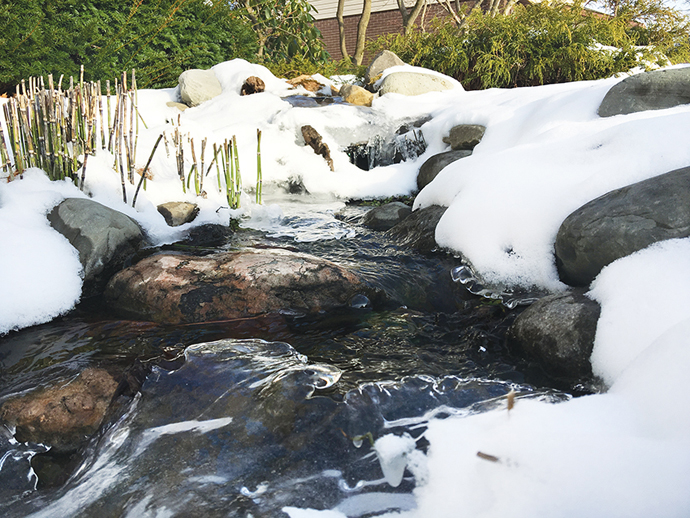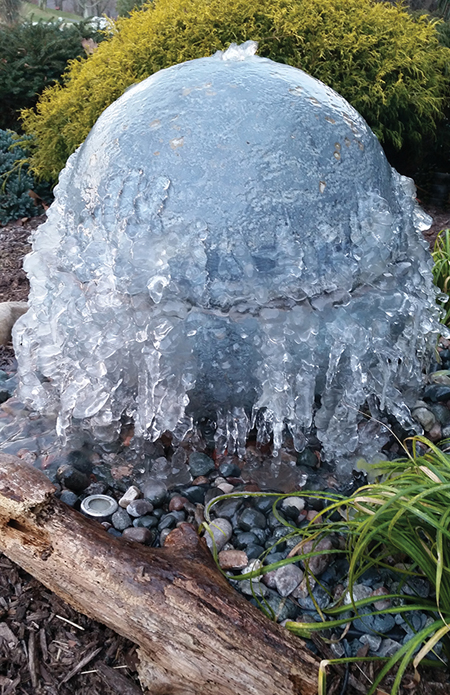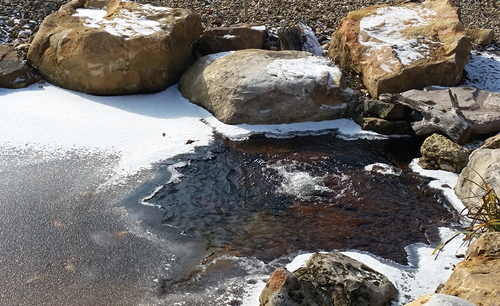
Most pond owners enjoy their water features on a three-season schedule. It starts with great anticipation in the spring, when the filters and pumps get plugged in. The pond and surrounding landscape proceed to undergo rapid changes through the summer, when plants are flourishing and time spent outdoors is fully maximized. Then suddenly, it’s fall. The days get shorter and cooler. And while the changing colors of autumn are a splendid sight, they also seem to signal a rapidly approaching winter. The pond owner begrudgingly admits that the pond’s year is almost over.
>> More images of these beautiful winter pond features via our Gallery Spotlight | Click here.
So why does a pond’s year have to be complete after only three seasons? Last I checked, there are four seasons in a year.
In the same vein, we pond contractors in the northern regions also revolve around a three-season calendar. We associate early spring with the start of a new season — time for home and garden shows and the return of positive cash flow, with pond openings and spring cleanouts. Summer brings a bounty of revenue in the form of new installations and renovations. Then comes fall, when we scramble to complete scheduled projects and throw nets on ponds. Finally, autumn wraps up with pond closings, putting them to bed for a deep, winter sleep.

Then comes three to four months of other stuff for us to do. Some of us plow snow; some take vacations; some visit with fellow contractors and attend conferences. We certainly stay busy, that’s for sure! But what about our customers? They stare out the window and wonder if their fish are still alive. They walk past their dry, covered-up fountainscape every morning when they leave for work. In the early evening, when the sky has been long dark, they see their expensive LED waterfall lights shining on — well, nothing.
What if I told you that your customers were missing out on something beautiful during these wintery days? What if there was a way for them to keep enjoying their water features, fountainscapes and ponds, and in turn thinking positively about their pond contractor?
It’s time for your customers to consider a fourth season of pond enjoyment. In my opinion, winter can be the most beautiful time of the year for a water feature. Snow and ice formations add a magical look to a waterfall, especially when highlighted by LED lighting. If your customers do not have a running water feature in the winter, they are missing out! Check out these benefits for your customers when they run their water features in the winter.
Visual Aesthetics

Sure, winter is cold. But it’s also beautiful. After a snowfall, the sights of a winding stream are enhanced by the monotone colors of snow and ice. The water in most ponds is generally clear this time of year, which helps the color scheme stand out in rocks and gravel. There’s something stunning about the stark contrast of dark-colored gravel alongside pure-white snow while being soothed by the melodic meandering of crystal clear water.
Another striking scene is the evolution of ice formations throughout the winter. Plunging temperatures allow ice to begin to form, at first along the pond and stream edges. As these areas continue to freeze, pond owners are treated to daily changes in the appearance of their features. This is particularly accentuated in areas of water splash and changes in current velocity, where ice formations can seem to come alive and grow in directions that didn’t even seem possible before. In some of the coldest climates, entire waterfalls can acquire layers of ice that hover above the water in motion. Additionally, the dancing light from an underwater LED can create an exciting atmosphere as it reflects off the water and the ice above it.
Studies show that some people suffer from elevated levels of depression in the winter. There may be many causes, including less sunlight and holiday and family-related stress.

Studies have also shown the positive effects that waterfalls can have on people. Splashing water creates negative ions that promote cleaner air, and the sights and sounds have a mesmerizing effect similar to a campfire. Our customers could certainly benefit from seeing and hearing their water features in the evening after a long day at work, don’t you think? Come to think of it, it’s probably more important in the winter than any other time of the year.
In freezing conditions, many natural water sources can become capped in ice. This can make it difficult for birds and other wildlife to find fresh water. By running a backyard water feature, the pond owner provides a perfect place for birds to gather for a drink or a quick splash.
This surely ties in with other benefits as well. Imagine seeing a bright red cardinal hopping along a snowy stream, curiously poking around for a drink. How could one not smile at that?
>> Sidebar | Need some Pond Winterization Tips? Click here.
Business Booster
Having your customers run their water features in the winter can have positive effects on your business in a variety of ways. For starters, it can make your spring maintenance easier. If a pond is completely shut down over the winter, it can potentially accumulate debris, such as leaves that may not be noticed until they sink to the bottom. That means additional organic material stuck in the bottom over winter, and more wet, heavy debris to remove during the spring cleanout. If the pond keeps running, those leaves will get drawn into the skimmer for easy removal.

If a pond has an abundance of oxygen-depleting muck on the bottom while it is closed for winter, fish could suffer from health-related issues. This is particularly true if the pond completely freezes over. But if the pond is left running, there is a much better chance that oxygen levels will stay high and the water quality will remain stable.
Another benefit to business is the simple fact that a flowing waterfall keeps the pond owner seeing and thinking about their pond — and the amazing contractor that cares for it. You open the door for a potential call over the winter to add a few new lights or perform another simple upgrade or service. You could also consider adding winter maintenance visits to your service offerings. You simply drop by as often as you see fit to check on the feature, adding coldwater bacteria, checking the water level, keeping an eye on ice dams and pulling debris from the skimmer, for example.
When you send out your spring cleanout letters in February, maybe you will notice an increase in responses if your customers have enjoyed their ponds all winter. For when a water feature is left inactive for an extended period of time, it may be somewhat forgotten about. This makes it no wonder why it takes a lot of customers several follow-ups before they finally respond and schedule their spring cleanouts.
Finally, I like to reinforce the positive vibes over the winter by sending my customers Christmas cards. It’s a simple, courteous gesture and a great way to keep spreading winter holiday cheer. Many customers become more like friends over time, so this is really a no-brainer. Plus, I’ve found that the act of writing personal greetings to customers helps me feel more connected to each of them, keeping their individual projects fresh in my memory.
Before Diving In

You obviously must consider how each water feature is constructed and determine if it is feasible to run it during winter, and if it is safe for fish. Research how to properly winterize the pond based on its construction and filtration type. Many ponds just aren’t set up to effectively run in the winter. Other styles of features, such as waterfalls and fountainscapes, may also be suitable for winter operation. It’s important to set your customers’ expectations and make them aware of things to look for during this time. You shouldn’t be held responsible if an ice dam causes water to leak from the pond, but you also should be responsible enough to make an informed recommendation regarding the suitability of running a particular water feature during the winter.
So start looking at the water features you build or maintain with the fourth season in mind. It can have many positive effects on your customers — and your business.


